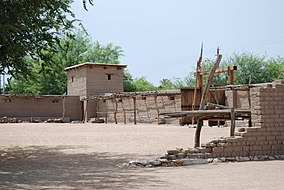Old Las Vegas Mormon Fort State Historic Park
| Old Las Vegas Mormon Fort State Historic Park | |
|---|---|
 Reconstructed portion of fort in downtown Las Vegas | |
| Location | Las Vegas, Nevada, United States |
| Coordinates | 36°10′50″N 115°08′01″W / 36.18056°N 115.13361°W[1] |
| Area | 3.16 acres (1.28 ha)[2] |
| Elevation | 1,923 ft (586 m)[1] |
| Designation | Nevada state park |
| Established | 1991 |
| Administrator | Nevada Division of State Parks |
| Website | Old Las Vegas Mormon Fort State Historic Park |
Las Vegas Mormon Fort | |
Nevada Historical Marker No. 35 | |
Las Vegas, Nevada | |
| Area | 0.699 acres |
| Built | 1855 |
| NRHP reference No. | 72000764 (original) 78003379 (increase) |
| MARKER No. | 35 |
| Significant dates | |
| Added to NRHP | February 1, 1972 |
| Boundary increase | December 12, 1978 |
Old Las Vegas Mormon Fort State Historic Park is a
Architecture and purpose
It was built in the New Mexico folk carpenter architectural style to facilitate travel along the Spanish Trail, and to enable Mormon missionary work in the Las Vegas Valley and to those traveling from New Mexico to California.[8]
The fort was surrounded by 14-foot (4.3 m) high adobe walls that extended for 150 feet (46 m). While called a fort, it was never home to any military troops but like many Mormon forts provided a defense and shelter for local settlers and travelers.
History
Mormon period
Civil War period
Around 1860, a small detachment of
The fort was called Fort Baker during the
Ranching/early Las Vegas period
In 1865,
Site preservation
Ownership of the fort and the land around it changed hands many times and it had several close calls with destruction. In 1955, the land was acquired by the Las Vegas Elks. With support of the Daughters of Utah Pioneers, the city of Las Vegas acquired the fort in 1989. Long-term protection was gained when the state acquired the site as a state park in 1991.[13]
A $4.5 million renovation and visitor center, designed by assemblageSTUDIO, was completed in 2005.[14] A visitor center explains the history of the fort.[3]
See also
- Mormon Station State Historic Park
- Las Vegas Mission
- Fort Supply - another Mormon fort with a similar purpose
- List of the oldest buildings in Nevada
References
- ^ a b "Las Vegas Mormon Fort (historical)". Geographic Names Information System. United States Geological Survey, United States Department of the Interior.
- ^ "Inventory of State Lands" (PDF). Nevada Division of State Lands. April 27, 2018. Retrieved November 23, 2019.
- ^ a b "Old Las Vegas Mormon Fort State Historic Park". Nevada State Parks. Department of Conservation and Natural Resources. Retrieved January 30, 2017.
- ISBN 1556701055.
- ^ Gene Amberg, Supervisor of Federal Aid Programs, Planning Dept. (November 8, 1971). "Las Vegas Mormon Fort". National Register of Historic Place Inventory Nomination. National Park Service. Retrieved January 30, 2017.
{{cite web}}: CS1 maint: multiple names: authors list (link) - ^ "The Las Vegas Mormon Fort". Historical Marker Database. June 16, 2016. Retrieved January 31, 2018.
- ^ "Las Vegas Old Mormon Fort". Nevada’s State Historical Markers. State Historic Preservation Office. Retrieved January 30, 2017.
- ^ "A History of The Old Fort". Friends Of The Fort. August 20, 1931. Retrieved March 17, 2024.
- San Bernardinoand Los Angeles.
- ^ Brig.-Gen. Richard H. Orton (1890). Records of California Men in the War of the Rebellion 1861 to 1867. Sacramento, Cal.: State Office. p. 21. Retrieved December 29, 2009.
- ISBN 978-0-8117-2978-9.
- ^ "Old Las Vegas Mormon Fort Historic State Park Brochure" (PDF). Archived from the original (PDF) on August 19, 2012. Retrieved January 30, 2011.
- ^ "History of Old Las Vegas Mormon Fort State Historic Park". Nevada State Parks. Department of Conservation and Natural Resources. Retrieved January 30, 2017.
- ^ "Old Las Vegas Mormon Fort Visitors Center". Special Collections and Archives. University of Nevada, Las Vegas. Retrieved November 23, 2019.
External links
- Old Las Vegas Mormon State Historic Park
- The Old Mormon Fort: Birthplace of Las Vegas, Nevada National Park Service Teaching with Historic Places Lesson Plan


